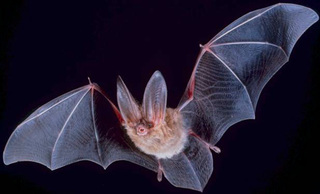
Townsend's big-eared bat
Order : Chiroptera
Family : Vespertilionidae
Subfamily : Vespertilioninae
Species : Plecotus townsendii
The Townsend's big-eared bat is listed as Vulnerable (VU), considered to be facing a high risk of extinction in the wild, on the IUCN Red List of Threatened Species
Namings for the Townsend
A young / baby of a Townsend is called a 'pup'. A Townsend group is called a 'colony or cloud'.Some facts about the
Townsend's big-eared bat
Adult weight : 0.014 kg (0.0308 lbs)
Maximum longevity : 21 years
Gestation : 78 days
Weaning : 42 days
Litter size : 1
Interval between litters : 365 days
Weight at birth : 0.002 kg (0.0044 lbs)
Facts about the Townsend's big-eared bat
OZARK BIG-EARED BAT Plecotus townsendii ingens FAMILY: Vespertilionidae STATUS: Endangered, Federal Register, November 30, 1979 DESCRIPTION: Plecotus townsendii is a medium-sized bat with forearms measuring 39 to 48 millimeters (mm) long and weighing 7 to 12 grams.
At the Bosque del Apache National Wildlife Refuge, Plecotus townsendii is listed as Western Big-eared Bat *23*.
†Plecotus townsendii is now known as Corynorhinus townsendii.
Townsend's big-eared bat (Plecotus townsendii) is just one of the mammals of the Chanslor Wetlands listed as a State Species of Special Concern.
Discussion--Plecotus townsendii is the only bat reported living in the cave. (Full text)
Townsend's big-eared bat (Plecotus townsendii) is now considered uncommon in California.
Townsend's Big-eared Bat (Plecotus townsendii) is listed as a species of concern and is of medium size with extremely long ears.
The Townsend's Big-eared Bat is a year round resident in Kansas and is known only from the south central part of the state (Barber, Kiowa, and Comanche counties).
However, the core range of the Townsend's big-eared bat is predominately west of the Rocky Mountains. (Full text)
Townsend's Big-eared Bat ClassOrderFamilySpecies Mammalia Chiroptera Vespertilionidae Plecotus townsendii Townsend's Big-eared Bat Distribution, Abundance, and Seasonality Townsend's big-eared bat is found throughout California, but the details of its distribution are not well known. (Full text)
Townsend's big-eared bat is present year-round in Montana, with summer or winter records from several localities (Hoffmann et al.
Present Status: The pale townsend's big-eared bat is widespread but rare in the Great Plains and northern Rocky Mountains.
Townsend's big-eared bat is approximately ten centimetres long while its ears are four centimetres long when extended.
bat, a subspecies of Townsend's big-eared bat, is listed as federally endangered by the US Fish and Wildlife Service.
The Townsend's big-eared bat is considered a rare and vulnerable species in South Dakota.
North Cascades National Park: Threatened and Endangered Species North Cascades Threatened and Endangered Species Pacific Western "Townsend's" Big-Eared BatCorynorhinus townsendii townsendii The Pacific Western "Townsend's" big-eared bat is approximately 4 inches in length with a wing span of 10-10-1/2 inches, and has, as its name implies, large ears.
Townsend's big-eared bat is a rare bat that has become much less common in the last 25 years.
Townsend's big-eared bats are found throughout western North America, from British Columbia south to Oaxaca, Mexico, with two endangered subspecies in isolated areas in the Ozark and Central Appalachian regions of the United States.
PHOTOS BY MERLIN D TUTTLE Townsend's big-eared bats are exceptionally sensitive to human disturbance.
Townsend's Big-eared Bats are adept at discriminating prey from background noise using echolocation.
Frequency: Currently, Townsend's big-eared bats are Species of Special Concern in California.
Special Significance Townsend's Big-eared Bats are at risk in British Columbia because of their small provincial population size, vulnerability
Townsend's big-eared bats are late flyers.
Posted on Sunday, July 14, 2002 @ 00:43:54 PSTWestern big-eared bat - Plecotus townsendii Townsend's big-eared bats are found throughout western North America, from British Columbia south to Oaxaca, Mexico, with two endangered subspecies in isolated areas in the Ozark and Central Appalachian regions of the United States.
Townsend’s big-eared bats are believed to feed entirely on moths.
More animals beginning with T
